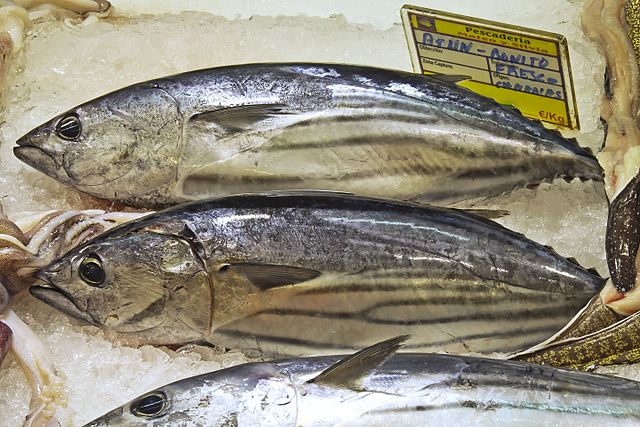Tuna:
What is it?, history, cultivation, nutritional value, uses, recipes, and more...
Yellowfin tuna is a pelagic oceanic species that inhabits all tropical and subtropical seas except the Mediterranean Sea. This species is found in open waters both above and below the thermoclines. Currently, tuna is the most heavily caught species for direct human consumption worldwide.
Índice
What is Yellowfin Tuna?
Yellowfin tuna is a fish with a streamlined body, small head, and eyes, and it’s characterized by having the second dorsal fin and anal fin being the longest among all tuna species. It possesses a swim bladder and has 26 to 35 denticles in the first gill arch.
It’s a quite striking fish. Along its dorsal area, it has lateral bands of blue and yellow. On its lower and ventral area, it’s silver in color with alternating vertical chains of stripes and dots. The second dorsal fin and anal fin are yellow. The pectoral fins, small fins located on the caudal peduncle, are lemon-yellow with black edges. It’s because of these yellow accents that the species gets its name.
The main body is a very dark metallic blue, turning silvery on the belly. Internally, the ventral surface of the liver is smooth, with the right lobe larger than the other two lobes, which distinguishes it from other tunas where the liver is striated, and the three lobes are roughly of the same length. Another distinction from other tuna species is its more streamlined body.
The average size of this tuna is around 130 cm in total length, although tunas up to 239 cm have been recorded (International Game Fish Association, 2001), weighing up to 200 kg. Thanks to its physique and warm-blooded nature, it can swim up to 70 kilometers per hour, allowing it to catch fast prey. As adults, they feed on other fish (including other tunas), squids, and crustaceans. This species hunts during the day and relies on its vision.
Adult yellowfin tuna are large and fast enough to escape most predators, but they can be preyed upon by marlins, toothed whales, mako sharks, and great white sharks.
These fish often swim in schools with fish of the same size, including other tuna species. Larger individuals are frequently seen with dolphins, porpoises, whales, and whale sharks.
History of Yellowfin Tuna
Yellowfin tuna inhabit all tropical and subtropical oceans, except the Mediterranean. They are typically found in waters ranging from 59°F to 88°F.
Tuna, a magnificent denizen of the deep blue oceans, has a history as rich and diverse as the waters it calls home. Among these, the yellowfin tuna (Thunnus albacares) stands as a remarkable species that has shaped both marine ecosystems and human cultures throughout time.
From the earliest days of human existence, coastal communities recognized the bounty of the sea and the nourishment it provided. Tuna, with its abundance and nutrient-rich flesh, quickly became a staple in their diets. The indigenous peoples’ connection to these oceanic giants was profound, extending beyond sustenance to rituals and stories that celebrated their majestic presence.
As civilizations evolved, so did the methods of tuna fishing. Ancient maritime cultures devised ingenious ways to capture these powerful swimmers, using tools crafted from natural materials. Nets, spears, and other primitive fishing gear were employed to secure the prized catch, laying the foundation for the evolving relationship between humanity and tuna.
With the rise of seafaring exploration, tuna’s reach expanded across oceans and continents. Mediterranean cultures, with their advanced maritime techniques, established tuna fisheries that centered around the bluefin tuna. These remarkable creatures, known for their immense size and strength, became symbols of maritime prowess and economic prosperity. The “tonnara” system, intricate nets designed to guide tuna into confined spaces, showcased the ingenuity of these ancient cultures in harnessing the power of the sea.
Tuna’s importance wasn’t limited to the Mediterranean. In the Pacific, island nations incorporated tuna fishing into their cultural identities. The Polynesian peoples, master navigators of the open ocean, developed an intimate understanding of tuna migrations and behaviors. This knowledge was passed down through generations, fostering a harmonious coexistence between communities and the marine environment.
As modernity swept in, the world saw a transformation in tuna fishing. Technological innovations revolutionized the industry, allowing for mass harvesting and global distribution. Canning and refrigeration techniques made tuna accessible to people around the world, turning it into a pantry staple. The iconic tuna salad and tuna sandwich became synonymous with convenience and nutrition, reflecting the evolving culinary landscape.
However, the 20th century also brought challenges. Rapid industrialization led to overfishing and depletion of tuna populations. Conservation efforts were initiated to safeguard the species and the delicate oceanic balance. International agreements and organizations aimed to regulate tuna fishing, set quotas, and promote sustainable practices.
Today, the yellowfin tuna remains a captivating figure in both culinary circles and marine conservation discussions. Its sleek, streamlined body and remarkable agility continue to inspire awe in fishermen and researchers alike. The allure of the hunt, the thrill of reeling in a powerful tuna, remains as strong as ever.
In conclusion, the history of tuna weaves a tale of symbiosis between humans and the sea. From its ancient significance to coastal communities to its modern role in global cuisine, tuna’s journey underscores the intricate connection between nature and culture. As we navigate an era of heightened environmental consciousness, the history of tuna serves as a reminder that our actions have consequences that ripple through the oceans, shaping the destiny of these remarkable creatures and the ecosystems they inhabit.

Common Name of Tuna
| Spanish | Atún aleta amarilla, albacora (Ecuador), rabil(México y Nicaragua), atún claro, junco |
| Catala | Tonyina clara |
| French | thon à nageoires jaunes, Albacore |
| English | Yellowfin Tuna |
| Euskera | Errolflin, Hegats-hori |
| Galician | Atún amarelo |
| Hawaiian | Ahi |
Scientific Name of Tuna
Thunnus albacares
Taxonomy of Tuna
| Kingdom | Animalia |
| Filo | Chordata |
| Class | Actinopterygii |
| Order | Perciformes |
| Family | Scombridae |
| Gender | Thunnus |
| Specie | T. albacares Bonnaterre, 1788 |
Synonymy of Tuna
Scomber albacares
Thunnus allisoni
Neothunnus catalinae
Etymology of Tuna
Tuna: a word derived from Hispano-Arabic “atún,” originating from the Classical Arabic تن (tunn), which in turn stems from the Latin “thunnus,” and this from Ancient Greek θύννος (thýnnos), from the verb θύνω (thýnō, “to rush forth”).
Tuna Reproduction
- Reproduction
Tuna Reproduction
The yellowfin tuna is an epipelagic species with migratory habits, inhabiting relatively shallow oceanic layers (0-100 m). They range from 32° 43' north to 37° 00' south and move periodically throughout the ocean based on their age. Individuals up to 50 cm in fork length tend to stay in coastal zones, exhibiting moderate migratory habits (30 miles), while adults engage in transoceanic and high-latitude migrations.
The spawning of this species occurs exclusively at night and depends on water temperature. It often takes place near the coast and can happen throughout the year, although the peak spawning season is during the summer months. Fertilization is external, and spawning takes place in surface waters. After fertilization, the eggs hatch rapidly, initiating the planktonic larval phase. The eggs are pelagic, spherical, transparent, and buoyant.
The minimum sexual maturity length in females is 59 cm. Males mature at smaller sizes than females, with a minimum sexual maturity length of less than 50 cm.
After mating, these fish release eggs and sperm into the water simultaneously for external fertilization. A female can spawn almost daily, releasing millions of eggs each time, up to ten million eggs per season. However, very few fertilized eggs reach maturity. The fry, or newly hatched fish, resemble nearly microscopic zooplankton. Those that aren't consumed by other animals develop rapidly and reach maturity in two to three years. Their lifespan is approximately 8 years.
Geographical Distribution of Tuna

Moquegua, Tacna, Ica, Lima, Arequipa, Piura, Tumbes, Lambayeque, La Libertad, Ancash
Year-Round Availability of Tuna
- In Peru, tuna is available year-round.
Varieties of Tuna
Among the existing tuna species are:
-
Northern Bluefin Tuna (Thunnus Alalunga)
-
Atlantic Bluefin Tuna (Thunnus Thynnus)
-
Yellowfin Tuna (Thunnus Albacares)
-
Bigeye Tuna (Thunnus Obesus)
-
Skipjack Tuna (Katsuwonus Pelamis)
-
Bullet Tuna (Auxis Thazard)
-
Fraser's Bonito (Sarda sarda)
-
In Peru, the Thunnus albacares and Thunnus obesus species are mainly commercialized.
Nutritional Value of Tuna
Tuna is a blue fish that provides abundant omega-3 fatty acids and is recommended for individuals with cardiovascular diseases, as it helps reduce cholesterol and triglyceride levels in the blood. Another property is its high content of high-quality protein, greater than most fish and meats.
It also stands out for containing B-group vitamins such as B2 (riboflavin), B3 (niacin), B6 (pyridoxine), B9 (folic acid), and B12 (cyanocobalamin), which promote nervous system function and blood formation. Additionally, its vitamin A content contributes to tissue and mucous maintenance and nervous system development. It also participates in bone growth and plays a role in enzyme and hormone production in the liver.
Its mineral contribution is significant due to high levels of phosphorus, iron, iodine, and magnesium.
Health Benefits of Tuna
Tuna is a protein-rich food that stands out for its high omega-3 fatty acid content. Furthermore, it boasts high levels of vitamins A and D.
Contraindications or Side Effects
Tuna, in general, is not recommended for individuals suffering from hyperuricemia or gout due to its purine content, which transforms into uric acid.
Likewise, consumption is not recommended for pregnant women and children due to its potential for storing mercury, which can lead to health problems.
| 10 Porciones por Kilogramo | |
| Tamaño de porción | 100g |
| Cantidad por porción Calorías |
141 |
| Cantidad por 100g | |
| Energía | 591 kJ |
| Grasa Total | 4.6 g |
| Sodio | ● |
| Carbohidratos totales | ● |
| Carbohidratos disponibles | ● |
| Fibra Dietaria | ● |
| Proteínas | 23.3 g |
| Calcio | ● |
| Fósforo | ● |
| Zinc | ● |
| Hierro | ● |
| Potasio | ● |
| Agua | 70.4 g |
| Cenizas | 1.6 g |
| Vitamina A | ● |
| Tiamina (B1) | ● |
| Riboflavina (B2) | ● |
| Niacina (B3) | ● |
| Vitamina C | ● |
| Acido Fólico (B9) | ● |
| β-Caroteno | 0 μg |
| Fuente: Tablas peruanas de composición de alimentos – Centro Nacional de Alimentación y Nutrición – Ministerio de Salud – Perú | |
Derived Products and Ways of Consuming Tuna
Uses of Tuna
The primary use of tuna is culinary. It’s the most consumed fish worldwide and one of the most popular canned products in our country. Additionally, its use as a dietary supplement is notable due to its varied nutritional benefits.
- Culinary
- Medicinal
Culinary Use of Tuna
Tuna is the most consumed fish globally. It can be consumed fresh, cooked, or canned. It is used and appreciated in cuisines from around the world. Its commercial boom was due to the globalization of Asian and Japanese cuisine, where it is used in dishes such as sushi and sashimi.
In addition to raw consumption, there are numerous ways to cook this fish. It's an ideal fish for grilling, frying, griddling, baking, and more. It lends itself to nearly all cooking methods.
In canned form, it can be found in natural juices, pickled, in vegetable oil, olive oil, among others, and can be used in salads, pizza, sandwiches, skewers, meatballs, etc.
It is also consumed as a salted product called "mojama."
Medicinal Use of Tuna
Among the primary contributions of tuna to overall health are:
- Heart and Cardiovascular
- Protection Prevention of HDL Cholesterol Accumulation, known as "bad cholesterol"
- Skin and Vision Protection Slowing Cognitive Decline
- Improvement of Mood



